
|
• Photographic Equipment •
Updated November 2009
Digital cameras I currently work with:
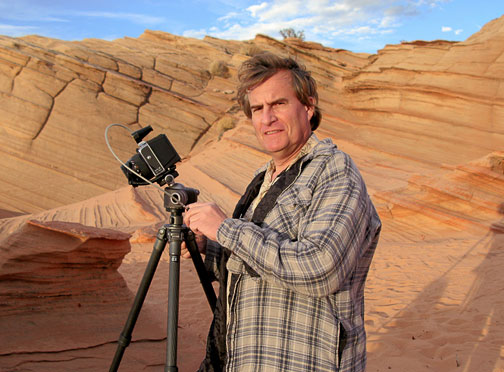
Phase One P45 Digital Back
My primary camera is now a Hasselblad medium format with a Phase One P45 Digital Back. I moved to the Phase One back because I like to work with medium format and large format cameras. Since there is no practical 4x5 digital solution at this time (I am not fond of scanning backs because they require extremely long exposure times), medium format digital backs are the best option at this time. The large file size, color depth, dynamic range and resolution of the Phase One back is very well suited to the creation of large Fine Art Prints.
Canon 1DsMk2
Prior to working with the Hasselblad-Phase One Digital Back combination, I used a Canon 1DsMk2 camera. This was a transitional film-to-digital time during which I continued to work with 4x5 while using the 1DsMk2. I did not upgrade to the current Canon 1DsMk3 preferring to move to a medium format digital system.
Gitzo Tripods and Really Right Stuff Ballheads
I continue to use Gitzo Tripods but I now use a Really Right Stuff (RSS) BH 55 ballhead instead of a Gitzo Ballhead. I have installed RRS quick release plate adapters on all my lenses and cameras.
Canon G9 Camera
I also use a Canon G9 camera for 'snapshot' type images. I have not seen the need to move to the newer Canon G10 or G11 since I use this camera only occasionally.
Film cameras I previously used:
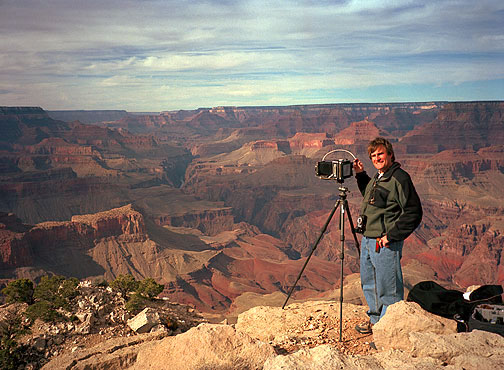
Linhof Master Technika 4x5
I use a large format Linhof Master Technika 4x5 as my primary camera. There are much lighter cameras available as well as cameras that are much faster to set up and operate. However, I have not found a camera which gives me better results than the 4x5.
One of the main reasons for the quality of the images I create with this camera is the time required to take each photograph as well as the meticulous care that this instrument promotes in me. Each image is composed very carefully while looking at a 4x5 ground glass which shows more details than any smaller format. The image has to be focused using a loupe to check for sharpness. The exposure must then be calculated manually, the lens closed and stopped down, and the film inserted before the photograph can be actually taken.
This may seem like a lengthy process and at times it can be. At others, if necessity demands it, I can take a 4x5 photograph in 5 minutes if I have to. Although this is fast for large format think about how much faster taking a photograph with a 35mm is. In many instances it only takes a few seconds to expose a frame with the smaller formats.
David Muench wrote that he considers the photographs he takes with his 4x5 to be "final statements." I agree with him. With smaller formats, when I take a photograph I like, I often think it would have been nice to use the 4x5 and I usually attempt to take the same photograph again later on. With the 4x5 once I get a pleasing photograph I consider it to be a final shot, a "final statement." Using the 4x5 gives me both the compositional quality, the sharpness, and the peace of mind which comes with knowing I could not have done better with a different format.
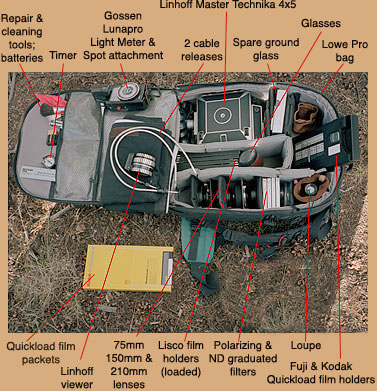
Film Changing Tent
I often use Quickload film packets because they are lighter to carry and come pre-loaded. However, at times it is necessary to load film myself usually because not all film types come in Quickload packets.
I have found that the easiest ways to load or unload film holders in the field is to use a film changing tent. In my case I use a Shadow Box tent which is pictured below. It conveniently folds like a dome tent into a small package about 5" by 15".
It is small and lightweight enough to be taken along on backpacking trips (it sure beats having to change your film at the bottom of your sleeping bag!). Recently I took the Shadow Box into a remote slot canyon and changed film in a location where the canyon was about 5 feet wide.
I had been shooting in this canyon all day when I noticed some very nice light on one of the arches located in the canyon. When I set up my camera I realized I had exposed all my films. So I set up the Shadow Box and went to work as the light was quickly fading. I was done in less than 5 minutes and was able to expose three sheets of film before the light was totally gone.
Fuji GS 6x17 Panoramic Camera
The Fuji 6x17 is my secondary format. In terms of image quality it equals the 4x5. However, its use is more limited since the extreme format ratio is not propitious to all images.
There is nothing quite like a good panoramic photograph however. The dynamism of the format, the broad sweep of the left to right movement it lends itself too, and the opportunity to create an image where movement can be carried across such a wide frame are unique.
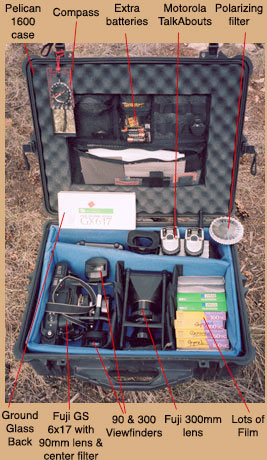
Gitzo Mountaineer Carbon Fiber Tripod
I use a tripod for all 4x5 photographs and most medium format photographs. I favor the carbon fiber models because they are lightweight. Carbon Fiber tripods are also easier to operate in winter since carbon fiber does not get cold. I use a quick release adaptor on each of my tripods and I have adaptor plates mounted on each of my cameras. This set up makes switching from one camera to another quick and easy.
I always carry my tripod in a bag to protect it from sand and rocks. I have found that this prevents inflicting damage to the tripod and increases its life span considerably. It also makes the tripod easier to carry since the bag has a shoulder strap which I just sling over my shoulder.
In July 2003 I purchased a second Gitzo Carbon Fiber tripod, the new Gitzo Explorer. I am quite excited about using this new tripod with a 4x5 view camera and seeing what it can do for me. I will have a full report and article when I have completed my testing. This tripod, and my first Gitzo Mountaineer CF, are both fitted with Gitzo Magnesium center ballheads (number 2 and 3).
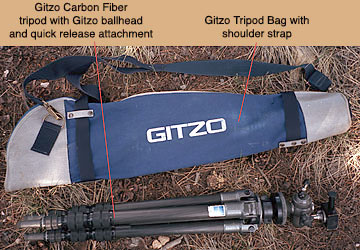
Shoulder Bag
This is the last piece of equipment shown here. I keep my most often used items in it: film, cleaning cloth, cable release, batteries, etc. It is also very practical for 4x5 holders, walkie talkie, light meter, etc. Since I usually carry a 6x4.5 reflex camera as a backup and "note pad" I put it in there as well.
I try to never leave anything on the ground while photographing since it both causes dirt to get into everything and increases the chances of loosing something. This bag is great in this respect since it allows me to keep all my spare gear in a safe place.
.
|
 |
|
|
|
|